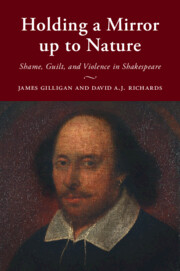Book contents
- Holding a Mirror up to Nature
- Holding a Mirror up to Nature
- Copyright page
- Dedication
- Epigraph
- Contents
- Introduction
- Chapter 1 Shame and Guilt in Personality and Culture
- Chapter 2 The Cycle of Violence in the History Plays
- Chapter 3 Fathers and Mothers
- Chapter 4 Make War, Not Love
- Chapter 5 The Motives of Malignity
- Chapter 6 Moral Nihilism and the Paralysis of Action:
- Chapter 7 Apocalyptic Violence
- Chapter 8 Transcending Morality, Preventing Violence
- Chapter 9 The Form and Pressure of Shakespeare’s Time and Ours
- Acknowledgments
- Bibliography
- Index
Chapter 8 - Transcending Morality, Preventing Violence
Measure for Measure, The Tempest, The Winter’s Tale, and The Merchant of Venice
Published online by Cambridge University Press: 25 November 2021
- Holding a Mirror up to Nature
- Holding a Mirror up to Nature
- Copyright page
- Dedication
- Epigraph
- Contents
- Introduction
- Chapter 1 Shame and Guilt in Personality and Culture
- Chapter 2 The Cycle of Violence in the History Plays
- Chapter 3 Fathers and Mothers
- Chapter 4 Make War, Not Love
- Chapter 5 The Motives of Malignity
- Chapter 6 Moral Nihilism and the Paralysis of Action:
- Chapter 7 Apocalyptic Violence
- Chapter 8 Transcending Morality, Preventing Violence
- Chapter 9 The Form and Pressure of Shakespeare’s Time and Ours
- Acknowledgments
- Bibliography
- Index
Summary
Shakespeare shows how violence can be prevented by replacing retribution, or revenge, with “restorative justice”: renouncing punishment toward others and the self, thus transcending both shame and guilt ethics, and giving violent offenders the opportunity and means to restore to the community what they had taken from it, thus reconciling with their community. In Measure for Measure, Duke Vincentio conducts a psychological experiment showing how the “retributive” apparatus of the state produced an attempted (judicial) murder and rape, whereas the Duke’s approach prevented all violence, by individuals and the state. The Tempest and The Winter’s Tale illustrate the same principles and outcome. The Merchant of Venice, however, shows how severely restorative justice is compromised when the primary cause and constituent of violence is ignored, and attention is paid only to its symptom or consequence (Shylock’s anger at Antonio’s anti-Semitism).
Keywords
- Type
- Chapter
- Information
- Holding a Mirror up to NatureShame, Guilt, and Violence in Shakespeare, pp. 119 - 136Publisher: Cambridge University PressPrint publication year: 2021

